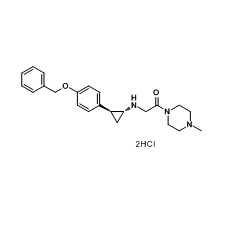| Cas No.: | 1781835-13-9 |
| Chemical Name: | RN1, RN 1 |
| Synonyms: | RN1, RN 1 |
| SMILES: | C1C=C(COC2C=CC([C@@H]3[C@H](NCC(N4CCN(C)CC4)=O)C3)=CC=2)C=CC=1.Cl.Cl |
| Formula: | C23H31Cl2N3O2 |
| M.Wt: | 452.417 |
| Sotrage: | 2 years -20°C Powder, 2 weeks 4°C in DMSO, 6 months -80°C in DMSO |
| Description: | RN-1 dihydrochloride is a potent, brain-penetrant, irreversible and selective lysine-specific demethylase 1 (LSD1) inhibitor with an IC50 of 70 nM. RN-1 dihydrochloride exhibits selectivity for LSD1 over MAO-A and MAO-B with IC50 values of 0.51 μM and 2.785 μM respectively[1][2]. |
| In Vivo: | RN-1 (3-10 mg/kg; i.p.; daily; for 2 or 4 consecutive weeks) dihydrochloride effectively induces fetal hemoglobin (HbF) levels in red blood cells and reduces disease pathology in SCD mice[2]. In C57BL/6 male mice, after intraperitoneal administration of RN-1 dihydrochloride (10 mg/kg), concentrations are detectable up to 24 h post dose in both plasma and brain tissues. The brain/plasma exposure ratio is 88.9. RN-1 dihydrochloride significantly impairs long-term memory, but not short-term memory[1]. Animal Model: Sickle cell disease (SCD) mice[2] Dosage: 3 mg/kg or 10 mg/kg Administration: i.p.; daily; for 2 or 4 consecutive weeks Result: Effectively induced HbF levels in red blood cells and reduced disease pathology in SCD mice. |
| In Vitro: | RN-1 dihydrochloride shows cytotoxic for ovarian cancer cells (SKOV3, OVCAR3, A2780 and cisplatin-resistant A2780cis), with IC50 values of ≈100-200 μM[3]. |

 DC Chemicals' products qualify for U.S. tariff exemptions. We guarantee no price increases due to customs duties and maintain stable supply, continuing to deliver reliable research solutions to our American clients.
DC Chemicals' products qualify for U.S. tariff exemptions. We guarantee no price increases due to customs duties and maintain stable supply, continuing to deliver reliable research solutions to our American clients.





















